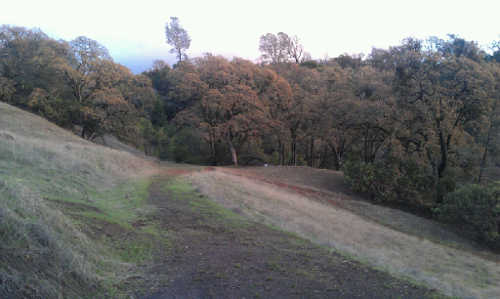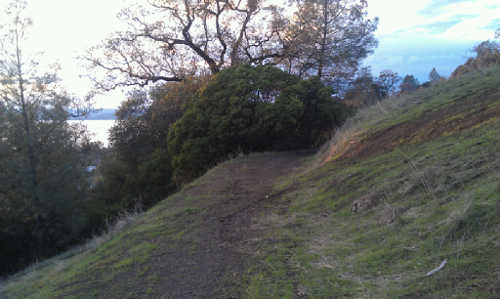
LAKE COUNTY, Calif. – County officials are working on a plan to address the issues surrounding the thousands of unbuildable paper subdivision lots around Lake County, particularly the Northshore, with one goal being to use the lots as part of the regional trail system.
Community Development Director Rick Coel and his staff got the go-ahead from the Board of Supervisors in November to continue with finalizing a draft of the 53-page paper subdivision management plan.
Coel told Lake County News that he anticipates taking a final draft of the plan back to the Board of Supervisors at the end of February.
The lots – close to 10,000 of them – are contained in several subdivisions that were created by land speculators in the early 20th century:
– Clear Lake Gardens, Nice: 1,975 parcels, four subdivisions, created in 1923 to 1924.
– Clear Lake Beach and College Heights, in the hills north and east of Lucerne: 6,340 parcels, nine subdivisions, created in 1924 to 1925.
– Clear Lake Beach Annex No. 2, Lucerne: 356 lots, one subdivision, created in 1925.
– Clearlake Oaks Subdivision: 367 lots, three subdivisions, created in 1925 to 1926.
– Mountain View, Clearlake Oaks: 222 lots, one subdivision, created in 1926.
– New Cacheville, located along Cache Creek near the eastern county line: 134 parcels, created 1912.
– Pine Dell, north of Clearlake Park: 337 parcels, one subdivision, created in 1924.
– Whispering Pines, Camp Calso and Sunset View, Cobb: 80 parcels, three subdivisions. Calso was created in 1926, Sunset View in 1942 and Whispering Pines in 1944.
The speculators who created the subdivisions didn’t provide for water, sewer, drainage or even adequate roads to support development, and in the decades since the lots have continued to cause problems. Many of the lots also are very small – some containing as little as 1,000 square feet of space.
The draft paper subdivision plan explains that many of the lots are “geographically unsuitable.”
Case in point: A rocky outcropping above Lucerne is divided up into a number of lots – none of them remotely buildable.
Coel said creating the plan began about two years ago as he and other county officials had discussions about the ongoing problems with the paper subdivision lots.
“The problems are numerous,” he said.
Due to the lack of control of the lots, there are issues with off-highway vehicle use, resulting in erosion problems, with illegal dumping also a common occurrence, according to Coel.
Illegal marijuana growing on the lots also has occurred, with Coel reporting that the New Cacheville subdivision near Lower Lake – an area that he said is commonly forgotten about – had a large marijuana grow a few years ago that was pulling water out of Cache Creek.
The problems also include having the lots continually being bought and sold, with some out-of-area buyers sinking large amounts of money into the property, believing they have valuable, buildable homesites, only to discover otherwise, Coel said.
The lots keep popping up on eBay and Craigslist, with people continuing to buy them. There is high turnover in the property ownership. “They get recycled,” said Coel.
County officials have reported getting calls from people who have invested their life savings in the idea of having a home with a lake view, only to come to Lake County and not even be able to find their lots.
Then there is the property tax issue. Many of the owners stop paying the property tax, according to Coel.
Clearlake Oaks residents Chuck Lamb and Holly Harris, who have studied the issues with the lots as part of their work with the Konocti Regional Trail System, reported that 25 percent of all of the subdivision parcels are in tax default from between five to 20 years.
About 5,000 to 6,000 of the lots have been in tax default for more five years, with another 400 lots in three- to four-year tax default, Harris said.
Many of the lot owners tend to believe that if they don't pay the property tax, the lots will simply go back to the county. But Harris said that's not true. Yearly taxes range between $55 and $75, with those amounts multiplied by the number of years the lots are behind in taxes.
“So, basically, the money keeps accruing,” Harris said.
That property tax isn't just owed to the county, but to local school and fire districts, which Harris suggested could be approached and asked if they would be willing to forgive a portion of the property taxes that are owed should the county try to acquire the lots.
Options for addressing the problem
Coel said one of the approaches to dealing with the lots is for the county to acquire and consolidate them into larger properties for purposes including oak woodlands mitigation.
Another option is to make the lots part of a regional trail system already under development in the county.
Harris said the pilot project for trails that they're proposing involves developing a trail system in the subdivisions above Lucerne.
She said the subdivision roads originally were offered to the county, but in the 1920s the county declined to take over those roads. Harris said the county could decide to take the roads back for public use, but not for public roads.
Those roads, she said, are “beautiful.” The ones above Marymount California University would create four-plus miles of hiking trails. She said they also have been in talks with the Mendocino National Forest about linking those trails to the forest.
Lamb noted that Marymount's new campus is a game changer for the county, and as a result it caused the Konocti Regional Trails group to reassess priorities for trail location.
With Marymount here, Lamb said there's almost a moral feeling that students should have that trail experience.
As a result, Konocti Regional Trails decided to focus on the area around Marymount's Lucerne campus as an opportunity for trail development, and a plan that would be good for Lucerne, the community and tourism. Lamb said it also would link in with the Ridgeline Trail.
Harris said one of the first things that needs to happen is that the board needs to have a discussion about whether or not they're interested in taking back some of the old subdivision roads into the county system, as that would be the backbone of the trails system. She said that plan will require that specific lots need to be acquired.
There could then be a fundraising effort in the community to acquire the lots, such as an “adopt a parcel” effort, she said.
At the November meeting, members of the Board of Supervisors acknowledged that the process of acquiring the lots could take decades.
However, it was reported that, when the county's redevelopment agency was still in operation, a request was put out to paper subdivision lot owners, asking if they wanted to donate the lots. The county received a favorable response from 15 percent of those property owners.
Harris said they want to send out a letter to see who is interested in donating the lots back to the county. They can then start looking at taking back tax default lots.
Harris acknowledged that it will be a longterm project. She said the county could do land swaps to get parcels needed for the trails, and could also merge lots and put in a building envelope, then sell the larger properties to bring money in for the project. Those are just some of the many ideas being considered.
However, Harris told Lake County News that she thinks the effort will be worth it.
“This is a phenomenal opportunity to create a ‘destination area,’” she said, noting the closeness to town and the ability to tap into Marymount California University.
Ultimately, the trails established above Lucerne would good for the students, residents and tourists, she said.
“The views are outstanding,” she said, with stunning views of Clear Lake and Mt. Konocti.
Except for the impact of dirt bikes and other off-highway vehicles, Harris said the bulk of potential trails remains in place, and will provide a direct connection to Mendocino National Forest and the back country.
There's also a second project proposal for the Mountain View subdivision in Clearlake Oaks, which is a smaller area than the Lucerne paper subdivision, according to Harris.
The Mountain View area has very high sediment loading due to erosion. The draft paper subdivision lot shows a picture of a fire hydrant on one of that subdivision's dirt roads, buried in sedimentation.
There also is the matter of illegal dumping in Mountain View, which volunteers have stepped in to help address, according to Coel.

Next steps
Among the many issues and challenges still ahead are funding, property acquisition and limited county staff, according to Harris.
She said there also are areas in the paper subdivisions where people have blocked off the public roads claiming that they’re private property, which she said needs to be addressed.
Harris said the supervisors also need to approve accepting the "offer for dedication" of the roads in those subdivisions for beneficial uses, but not back into the county road system.
“We had planned on using these roads as the trails – they are perfect. If they don't do this, it will be a decades long process,” she said.
There also will need to be an effort to search for grants and other funding to repair the off-highway vehicle damage, which Harris said is “extensive.”
Regarding acquiring the parcels, Harris said donations are easy, but tax defaults with have varying degrees of complexity. “We need a way to acquire these, without letting the unscrupulous land buyers acquire them to resell on eBay and other places.”
Taking over the lots when property tax is owed isn’t a simple matter. The outstanding amount would have to be paid, although no property tax would be owed once the land is owned by the county, County Counsel Anita Grant told the Board of Supervisors at its November meeting.
Grant, at that time, volunteered to have her office work on studying the issues surrounding the acquisition of the property, noting it could save the county a lot of time.
Grant said she could review the existing law to see what mechanisms may be available to the board to acquire the lots with less fiscal impact, including not having to pay accumulated penalties and fines.
Harris said there may be another way to address the lots in tax default – through the Teeter Plan, an alternate method of dealing with secured property tax revenue, which County Administrative Officer Matt Perry mentioned at the November board meeting.
According to county documents, under the Teeter Plan, penalties and interest collected on delinquent secured taxes are required to be held in trust in the Tax Loss Recovery Fund, the primary purpose of which is to cover losses that may occur as a result of special sales of tax-defaulted property.
Harris said Konocti Regional Trails leadership is now working on fleshing out more of the proposed trail project in Lucerne so that the supervisors understand the costs and issues.
“We did have a trails meeting the beginning of December, and everyone is excited at the idea of developing trails in Lucerne, but there was no additional input on the paper subdivision plan itself,” she said.
Coel told Lake County News that he’s adding some items to the draft plan, mainly involving revisions regarding the clarification of the potential options available to the county for purchasing and accepting the lots.
He said he also wants to make sure the county has the proper internal review procedures in place whenever accepting or purchasing the lots in order to minimize liability exposure to the county and taxpayers.
Email Elizabeth Larson at

 How to resolve AdBlock issue?
How to resolve AdBlock issue? 



